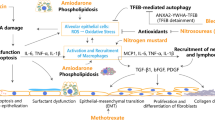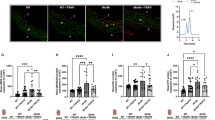Abstract
Neprilysin (NEP) is a cell surface metallopeptidase found in many tissues. Based mostly on pharmacological manipulations, NEP has been thought to protect blood vessels from plasma extravasation. We have suggested that NEP may protect against pulmonary vascular injury. However, these prior studies did not utilize mice which overexpress NEP. The aims of the present investigation were to develop and characterize doubly transgenic (DT) mice that overexpress NEP universally and conditionally, and to investigate the protective effect that overexpressed NEP may have against plasma extravasation in the vasculature. The duodenum, which is often used to assess vascular permeability, and in which the NEP protein was overexpressed in our DT mice two-fold, was selected as our experimental preparation. We found that substance P-induced plasma extravasation was decreased substantially (3.5-fold) in the duodenums of our doxycycline-treated DT mice, giving independent evidence of NEP’s protective effects against plasma extravasation. Transgenic lung NEP protein was not stably expressed in the DT mice, so we were not able to test the effect of NEP overexpression in the lung. Although initially overexpressed nearly nine-fold at that site, pulmonary NEP protein overexpression eventually dissipated. Surprisingly, at a time when there was no lung transgenic NEP protein overexpression, lung NEP mRNA expression was still increased 23-fold, indicating that the expression defect probably is not transcriptional. These studies help to characterize our complex transgenic model of NEP overexpression and further demonstrate NEP’s protective effects against plasma extravasation.






Similar content being viewed by others
References
Bertrand C, Geppetti P, Baker J, Petersson G, Piedimonte G, Nadel JA (1993) Role of peptidases and NK1 receptors in vascular extravasation induced by bradykinin in rat nasal mucosa. J Appl Physiol 74:2456–2461
Brakebusch C (2010) Generation and analysis of genetically modified mice. In: Hau J, Shapiro SJ (eds) Handbook of laboratory animal science. CRC Press, Boca Raton, FL pp 653–666
Dempsey EC, Wick MJ, Karoor V, Barr EJ, Tallman DW, Wehling CA, Walchak SJ, Laudi S, Le M, Oka M, Majka S, Cool CD, Fagan KA, Klemm DJ, Hersh LB, Gerard NP, Gerard C, Miller YE (2009) Neprilysin null mice develop exaggerated pulmonary vascular remodeling in response to chronic hypoxia. Am J Pathol 174:782–796
Dempsey EC, Loomis ZL, Wick MJ (2011) Recent advances in lung neuropeptide biology using neprilysin and VIP knockout mice. Drug Discov Today, DM 7:67–75
Figini M, Emanueli C, Grady EF, Kirkwood K, Payan DG, Ansel J, Gerard C, Geppetti P, Bunnett N (1997) Substance P and bradykinin stimulate plasma extravasation in the mouse gastrointestinal tract and pancreas. Am J Physiol 272:G785–G793
Gendron G, Simard B, Gobeil F Jr, Sirois P, D’Orléans-Juste P, Regoli Domenico (2004) Human urotensin-II enhances plasma extravasation in specific vascular districts in Wistar rats. Can J Physiol Pharmacol 82:16–21
Goodman OB Jr, Febbraio M, Simantov R, Zheng R, Shen R, Silverstein RL, Nanus DM (2006) Neprilysin inhibits angiogenesis via proteolysis of fibroblast growth factor-2. J Biol Chem 281:33597–33605
Johnson JA, Hemnes AR, Perrien DS, Schuster M, Robinson LJ, Gladson S, Loibner H, Bai S, Blackwell TR, Tada Y, Harral JW, Talati M, Lane KB, Fagan KA, West J (2012) Cytoskeletal defects in Bmpr2-associated pulmonary arterial hypertension. Am J Physiol Lung Cell Mol Physiol 302:L474–L484. doi:10.1152/ajplung.00202.2011
Karoor V, Oka M, Walchak SJ, Hersh LB, Miller YE, Dempsey EC (2013) Neprilysin regulates pulmonary artery smooth muscle cell phenotype through a platelet-derived growth factor receptor-dependent mechanism. Hypertension 61:921–930
Kisseberth WC, Brettingen NT, Lohse JK, Sandgren EP (1999) Ubiquitous expression of marker transgenes in mice and rats. Dev Biol 214:128–138. doi:10.1006/dbio.1999.9417
Koetsier PA, Mangel L, Schmitz B, Doerfler W (1996) Stability of transgene methylation patterns in mice: position effects, strain specificity and cellular mosaicism. Transgenic Res 5:235–244
Leissring MA, Farris W, Chang AY, Walsh DM, Wu X, Sun X, Frosch MP, Selkoe DJ (2003) Enhanced proteolysis of β-amyloid in APP transgenic mice prevents plaque formation, secondary pathology, and premature death. Neuron 40:1087–1093
Li C, Hersh LB (1995) Neprilysin: assay methods, purification, and characterization. Methods Enzymol 248:253–263
Lorthongpanich C, Cheow LF, Balu S, Quake SR, Knowles BB, Burkholder WF, Solter D, Messerschmidt DM (2013) Single-cell DNA-methylation analysis reveals epigenetic chimerism in preimplantation embryos. Science 341:1110–1112. doi:10.1126/science.1240617
Lu B, Gerard NP, Kolakowski LF Jr, Bozza M, Zurakowski D, Finco O, Carroll MC, Gerard C (1995) Neutral endopeptidase modulation of septic shock. J Exp Med 181:2271–2275
Lu B, Figini M, Emanueli C, Geppetti P, Grady EF, Gerard NP, Ansell J, Payan DG, Gerard C, Bunnett N (1997) The control of microvascular permeability and blood pressure by neutral endopeptidase. Nat Med 3:904–907
Maguer-Satta V, Besancon R, Bachelard-Cascales E (2011) Concise review: neutral endopeptidase (CD10): a multifaceted environment actor in stem cells, physiological mechanisms, and cancer. Stem Cells 29:389–396. doi:10.1002/stem.592
Mangiafico S, Costello-Boerrigter LC, Andersen IA, Cataliotti A, Burnett JC Jr (2013) Neutral endopeptidase inhibition and the natriuretic peptide system: an evolving strategy in cardiovascular therapeutics. Eur Heart J 34:886–893c. doi:10.1093/eurheartj/ehs262
McDonough AA, Veiras LC, Minas JN, Ralph DL (2015) Considerations when quantitating protein abundance by immunoblot. Am J Physiol Cell Physiol 308:C426–C433. doi:10.1152/ajpcell.00400.2014
Melichar B, Hyspler R, Kalábová H, Dvorák J, Tichá A, Zadák Z (2011) Gastroduodenal, intestinal and colonic permeability during anticancer therapy. Hepatogastroenterology 58:1193–1199
Perl AK, Tichelaar JW, Whitsett JA (2002) Conditional gene expression in the respiratory epithelium of the mouse. Transgenic Res 11:21–29
Pfaffl MW (2001) A new mathematical model for relative quantification in real-time RT-PCR. Nucleic Acids Res 29:e45
Plotkin JB, Kudla G (2011) Synonymous but not the same: the causes and consequences of codon bias. Nat Rev Genet 12:32–42. doi:10.1038/nrg2899
Ramirez A, Milot E, Ponsa I, Marcos-Gutierrez C, Page A, Santos M, Jorcano J, Vidal M (2001) Sequence and chromosomal context effects on variegated expression of keratin 5/lacZ constructs in stratified epithelia of transgenic mice. Genetics 158:341–350
Rubinstein I, Iwamoto I, Ueki IF, Borson DB, Nadel JA (1990) Recombinant neutral endopeptidase attenuates substance P-induced plasma extravasation in the guinea pig skin. Int Arch Allergy Appl Immunol 91:232–238
Saria A, Lundberg JM (1983) Evans blue fluorescence: quantitative and morphological evaluation of vascular permeability in animal tissues. J Neurosci Methods 8:41–49
Schonig K, Bujard H, Gossen M (2010) The power of reversibility regulating gene activities via tetracycline-controlled transcription. Methods Enzymol 477:429–453. doi:10.1016/S0076-6879(10)77022-1
Sturiale S, Barbara G, Qiu B, Figini M, Geppetti P, Gerard N, Gerard C, Grady EF, Bunnett NW, Collins SM (1999) Neutral endopeptidase (EC 3.4.24.11) terminates colitis by degrading substance P. Proc Natl Acad Sci USA 96:11653–11658
Sulpizio AC, Pullen MA, Edwards RM, Brooks DP (2004) The effect of acute angiotensin-converting enzyme and neutral endopeptidase 24.11 inhibition on plasma extravasation in the rat. J Pharmacol Exp Ther 309:1141–1147
Szabo A, Menger MD, Boros M (2006) Microvascular and epithelial permeability measurements in laboratory animals. Microsurgery 26:50–53. doi:10.1002/micr.20210
Turner AJ, Nalivaeva NN (2006) Proteinase dysbalance in pathology: the neprilysin (NEP) and angiotensin-converting enzyme (ACE) families. Cell Mol Biol (Noisy-le-grand) 52:40–48
Urlinger S, Baron U, Thellmann M, Hasan MT, Bujard H, Hillen W (2000) Exploring the sequence space for tetracycline-dependent transcriptional activators: novel mutations yield expanded range and sensitivity. Proc Natl Acad Sci USA 97:7963–7968. doi:10.1073/pnas.130192197
Van Keuren ML, Saunders TL (2004) Rederivation of transgenic and gene-targeted mice by embryo transfer. Transgenic Res 13:363–371
Walters EM, Bauer BA, Franklin CL, Evans TJ, Bryda EC, Riley LK, Critser JK (2009) Mutational insertion of a ROSA26-EGFP transgene leads to defects in spermiogenesis and male infertility in mice. Comp Med 59:545–552
Wang X, Liu P, Zhu H, Xu Y, Ma C, Dai X, Huang L, Liu Y, Zhang L, Qin C (2009) miR-34a, a microRNA up-regulated in a double transgenic mouse model of Alzheimer’s disease, inhibits bcl2 translation. Brain Res Bull 80:268–273
Welinder C, Ekblad L (2011) Coomassie staining as loading control in western blot analysis. J Proteome Res 10:1416–1419. doi:10.1021/pr1011476
Wick MJ, Buesing EJ, Wehling CA, Loomis ZL, Cool CD, Zamora MR, Miller YE, Colgan SP, Hersh LB, Voelkel NF, Dempsey EC (2011) Decreased neprilysin and pulmonary vascular remodeling in chronic obstructive pulmonary disease. Am J Respir Crit Care Med 183:330–340. doi:10.1164/rccm.201002-0154OC
Wortge S, Eshkind L, Cabezas-Wallscheid N, Lakaye B, Kim J, Heck R, Abassi Y, Diken M, Sprengel R, Bockamp E (2010) Tetracycline-controlled transgene activation using the ROSA26-iM2-GFP knock-in mouse strain permits GFP monitoring of DOX-regulated transgene-expression. BMC Dev Biol 10:95. doi:10.1186/1471-213X-10-
Acknowledgments
Supported by Grants received from the National Heart, Lung and Blood Institute (NHLBI RO1 HL078929, PPG HL14985 and RO3 HL095439) and the Department of Veterans’ Affairs (Merit Review to ECD). YEM is supported by NCI P50 CA058187 and NCI P30 CA046934. The authors wish to thank Dr. James West (Vanderbilt University) for the FVB/N Rosa26- rtTA2-M2 singly transgenic mice, Dr. Lou Hersh (University of Kentucky) for the NEP-pCSC-SP-PW lentiviral vector, and Dr Jeffrey Whitsett (Cincinnati Children’s Hospital) for the reengineered Tet-O-CMV vector and FVB/N SP-C-rtTA transgenic mice. The authors also wish to thank Sandra Walchak and Andy Poczobutt for expert technical and administrative assistance.
Author information
Authors and Affiliations
Corresponding author
Ethics declarations
Conflict of interest
The authors of this manuscript declare that they have no conflicts of interest.
Ethical standards
All applicable international, national, and/or institutional guidelines for the care and use of animals (mice) were followed in the experiments described in this manuscript.
Electronic supplementary material
Below is the link to the electronic supplementary material.
Rights and permissions
About this article
Cite this article
Wick, M.J., Loomis, Z.L., Harral, J.W. et al. Protection against vascular leak in neprilysin transgenic mice with complex overexpression pattern. Transgenic Res 25, 773–784 (2016). https://doi.org/10.1007/s11248-016-9969-x
Received:
Accepted:
Published:
Issue Date:
DOI: https://doi.org/10.1007/s11248-016-9969-x




